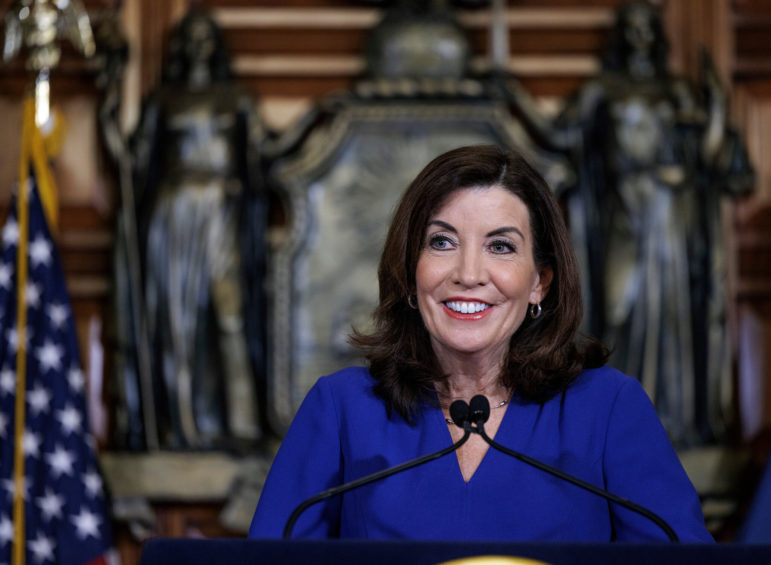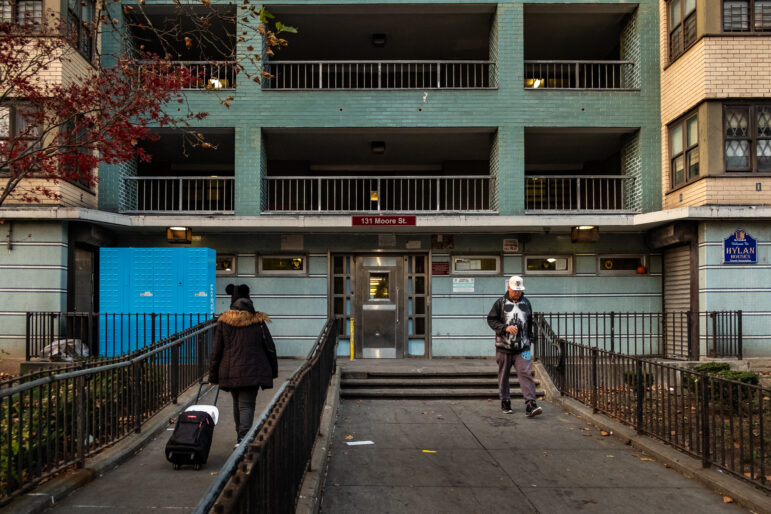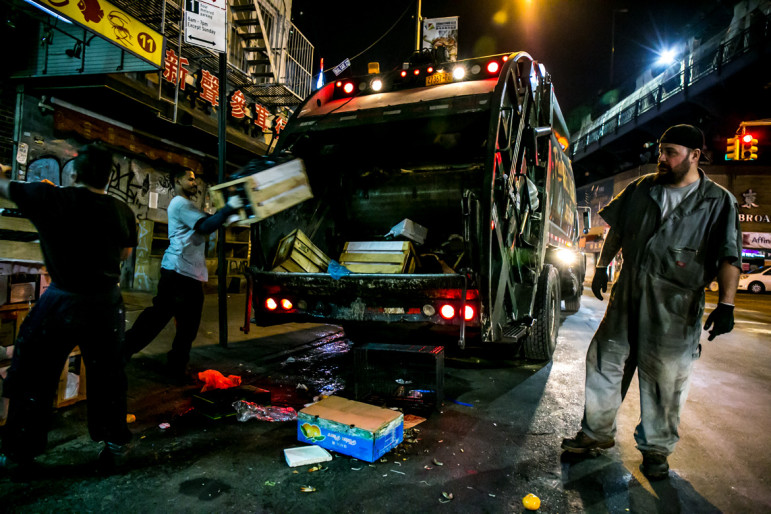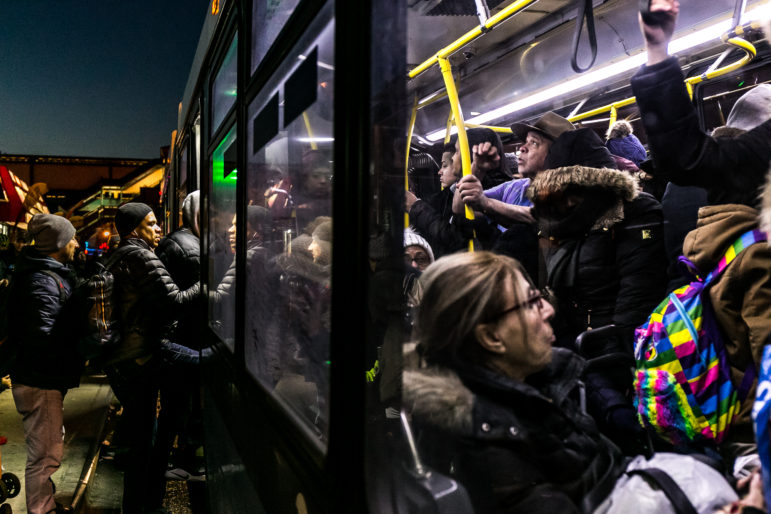“It’s pretty dreadful,” one housing advocate said. “The governor decided to-go drinks and a stadium in Buffalo were more important than housing the homeless and marginalized New Yorkers.”

Mike Groll/Office of Governor Kathy Hochul
Gov. Kathy Hochul discusses the Fiscal Year 2023 State Budget during a news conference at the State Capitol Thursday.A decades-long affordable housing crisis has perpetuated mass homelessness across New York State, inflicting seismic social and financial consequences. You might not know it by looking at the state’s $220 billion tentative spending plan.
Lawmakers are poised to pass a budget that does little to house homeless New Yorkers, according to exasperated advocates and policymakers.
“It’s pretty dreadful,” said Legal Aid Society Supervising Attorney Judith Goldiner. “The governor decided to-go drinks and a stadium in Buffalo were more important than housing the homeless and marginalized New Yorkers.”
During protracted negotiations, lawmakers axed a proposed Section 8-style rent subsidy for New Yorkers experiencing or at-risk of homelessness after Gov. Kathy Hochul and her budget team said it was too expensive—though bill backers dispute her administration’s math.
The budget—which lawmakers have not yet finalized, though they announced a “conceptual agreement”— also excludes new funding for homeless New Yorkers with HIV outside the five boroughs, depletes a rental assistance program benefiting homeless immigrants without legal status and codifies language that shifts the cost burden of an increase to an existing state housing voucher on to New York City.
The Assembly and Senate had included $250 million to jumpstart the Housing Access Voucher Program (HAVP) in their one-house budget proposals last month, but the proposed subsidy, which would prioritize homeless New Yorkers, did not make it into the final plan.
Hochul and her budget team said the program would carry a $6 billion price tag, New York Focus reported, but HAVP Senate sponsor Brian Kavanagh said legislators never saw a “rigorous analysis” of the program showing that number. The $250 million proposed by the legislature would have been enough to house 20,000 individuals and families who are homeless or facing eviction, he added.
“We should not be buying into the argument that the problem is so large that we shouldn’t take initial steps to address it,” Kavanagh said. “The bill is about shifting the focus from shelter and temporary accommodation to permanent housing as the solution to homelessness.”
Advocates said excluding HAVP from the largest budget in state history would set back families who face eviction or find themselves stuck in city shelters for an average of 18 months.
“HAVP would have gone a long way to ensure New York families can stay in their homes and out of shelter,” said the Family Homelessness Coalition (a City Limits funder) in a statement. “Without it, thousands of families will be pushed further to the brink of homelessness.”
About 47,000 New Yorkers, including around 14,600 children, spend each night in a shelter overseen by the Department of Homeless Services, according to daily data tracked by City Limits. Overall, more than 60,000 different New Yorkers stayed in a municipal homeless shelter in February, according to the latest data reported under city law and compiled by City Limits. An estimated 92,000 people are homeless statewide.
The budget specifically moves money from another rent relief fund touted as a way to house immigrants without legal documentation whose immigration status precludes them from most housing assistance programs.
The state has forced New York City to pay a portion of FHEPS rental vouchers for homeless families who receive public assistance out of the same pot of money. Under the plan, the city would cover the difference between the previous rate of the state’s FHEPS voucher and the new, higher voucher values pegged to fair market rent (FMR)—meaning fewer funds leftover for the rental assistance initiative intended for immigrants.
Hochul had signed the state FHEPS increase into law at a celebratory press conference late last year, but critics say the cost-shifting maneuver continues a Cuomo-era trend of the state pushing the financial burden for homeless services to the city.
A spokesperson for the state’s Budget Office called criticism of that arrangement a “false premise.”
FHEPS is considered an eligible use under the state’s $100 million relief program, “meaning the State is paying for FHEPS, and the program has never reserved funds for any particular group of people,” the spokesperson said.

Don Pollard/Office of Governor Kathy Hochul
Hochul and lawmakers at a press conference in December, signing the bill that increased the value of the state’s FHEPS rental assistance vouchers.Advocates have also pointed out that lawmakers failed to include $10 million in the budget to make rental assistance vouchers for homeless New Yorkers with HIV work outside of New York City. Beyond the five boroughs, HIV Emergency Shelter Allowance vouchers are capped at $480, but municipalities are able to opt in to increase the voucher value. None have chosen to increase their financial obligation, however.
Lawmakers had backed a proposal to give every income-eligible person with HIV access to a voucher pegged at FMR, with the state covering the difference between the current rate and FMR. That proposal did not make it into the final budget, either.
The issue “remained unaddressed throughout the Cuomo administration, and Governor Hochul is merely continuing his negligence,” the organization HousingWorks said in a statement.
The budget does, however, include funding to prevent more people from becoming homeless.
New York added $800 million to its tapped-out Emergency Rental Assistance Program (ERAP), which reimburses property owners who missed out on rent payments during the pandemic. The state’s Landlord Rental Assistance Program will also receive another $125 million.
More than 322,000 New Yorkers have applied for ERAP, with the state so far able to distribute checks on behalf of about 135,000 households, according to OTDA’s latest program report. The program ran out of money in November of last year before receiving modest allocations from the federal government. Tens of thousands of applicants remain on a de facto waiting list when money becomes available.
Hochul has also touted a five year, $25 billion plan to create or preserve 100,000 affordable homes, including 10,000 units of supportive housing.
“We talked about how expensive things are—housing. This is not new, but it has gotten much, much worse,” she said at a press conference discussing the budget Thursday.
But a mechanism for building those units did not make it into the final budget.
Hochul had proposed a modification to the state’s controversial 421a tax exemption program, which provides hefty tax breaks to developers in exchange for some income-restricted housing. The vast majority of the affordable units in buildings that qualify for the tax exemption are actually priced for people earning six figures, and many 421a buildings have no affordable units at all.
The 421a program expires in June, setting up a showdown in Albany over how to provide development subsidies in exchange for truly affordable housing. Hochul has proposed decreasing the maximum allowable rents on affordable units. Progressive lawmakers want a complete overhaul with more targeted subsidies.
A replacement is among the “urgent items that need to be addressed before the end of the session,” Hochul said. “We will have time to do that.”
A few other Hochul-backed proposals did not make it into the budget, either. Her January Executive Budget included a plan to override local single-unit zoning and allow property owners to build or legally rent accessory dwelling units (ADUs)—extra residential rental spaces on their land. She soon backed off that plan after facing backlash from suburban lawmakers and residents, most notably her Democratic primary opponent Tom Suozzi.
And Hochul said she supported changes to New York City zoning law that caps floor area ratio (FAR) for residential projects at 12. FAR refers to the maximum square footage of a building allowed by local zoning rules, based on multiples of the lot size. So an FAR of 12 means 12 times the size of the property lot. The state did not take up that plan in the budget.
Still, the coming battle over a 421a replacement could keep the wind in the sails of other housing proposals, like a bill to prevent evictions and limit rent increases without “good cause.”
“There are a number of housing issues that are still on the table,” Kavanagh said.








